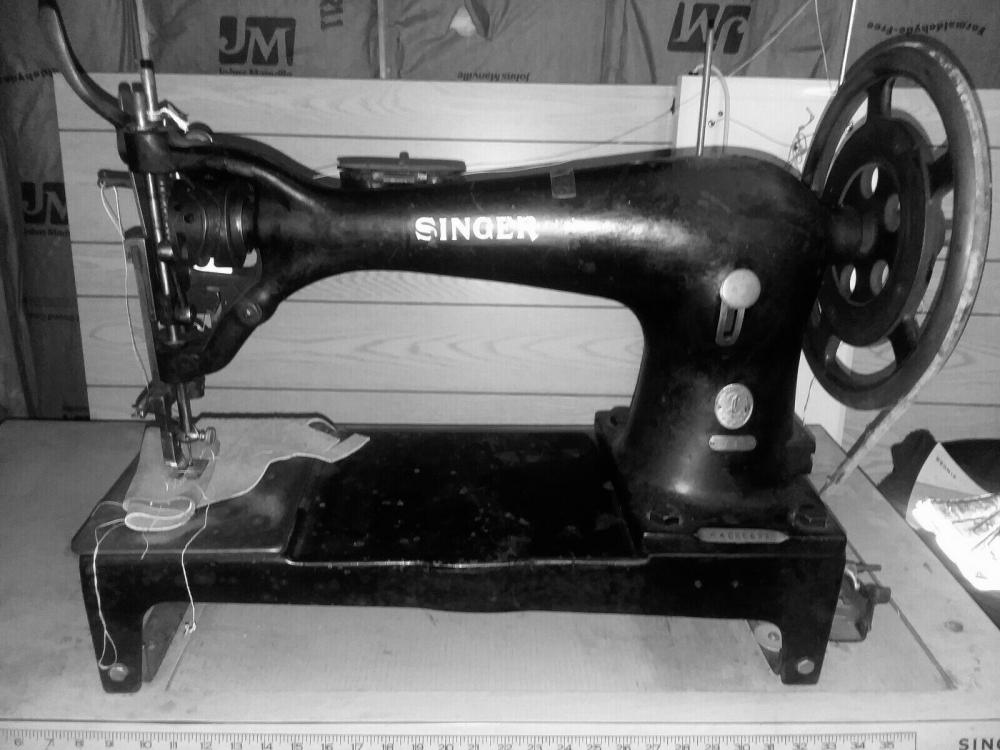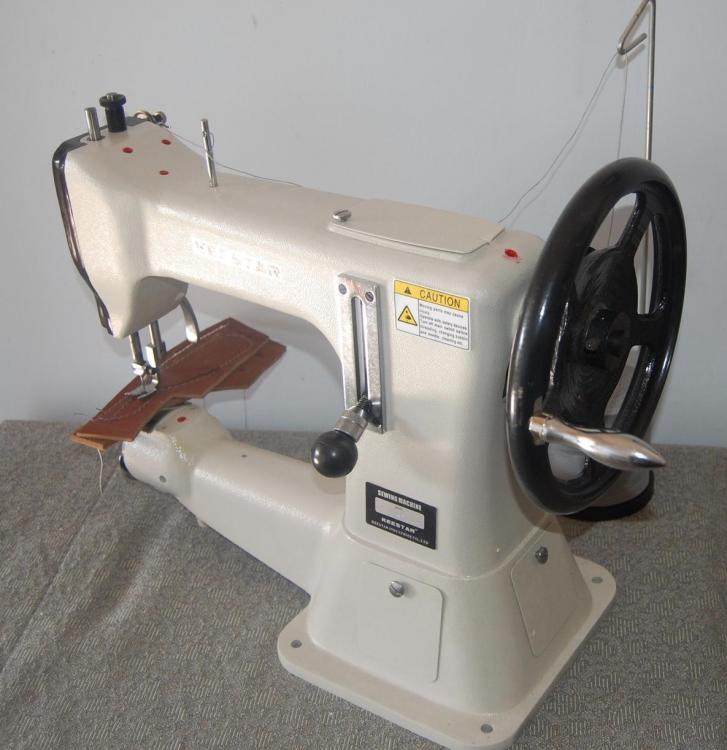-
Posts
794 -
Joined
-
Last visited
Content Type
Profiles
Forums
Events
Blogs
Gallery
Everything posted by DonInReno
-

Cobra 26-hook not catching top thread
DonInReno replied to ScrewItUpSteph's topic in Leather Sewing Machines
The thicker thread and needle is probably giving a better target for the hook to grab. As with all issue of this type always change to a new needle in case it’s just a bent needle causing the problem. Then adjust hook/needle timing and clearance. There are many discussions covering that topic. Best of luck! -

Simple chart of models & key specs
DonInReno replied to Fognozzle's topic in Leather Sewing Machines
I enjoy keeping a lookout for used machines of various types and the biggest limitation to a simple list of machines would be the number of machines that would be overlooked because they aren’t on the list. First, a person should read the great write up that Wiz put together, then reread it about once a week while searching for a machine. It’s much more important to understand the design you need, rather than the specific make and model, because of the variety in rebrands, older models, etc. The easiest thing to look for is a built in walking foot design - simple machines without one are rarely capable of sewing with heavy thread. Of course this generalization will let machines like the Ga-5 slip past your radar. No less than a dozen companies across the planet have marketed that old design under probably 50 different names/models. The other danger of going off a list of used machines great for leather is it doesn’t emphasize the importance of availability of parts. Not all good machines can be easily fixed if something is missing or broken. Even a clone of a well supported machine may have some parts that don’t follow the “standard” design. Then there are unbranded and unmarked machines that can be just as good as the machine it copies, but there are zero markings or part numbers to go off of. Special purpose industrials may be 99.9% the same as a popular model, but have been given a model number that doesn’t even give a glimpse of what it’s based on. Foreign or older machines often aren’t prominently marked. The other machines to look out for are machines, even popular models, that have been modified for a very specific purpose, making them almost useless for normal sewing. Book binding machines or those for some industrial products look just like some leather sewers, but may not be capable of reasonably short stitches or may be completely missing feeding mechanisms. Enjoy your search! -

Educate me on my Champion machine
DonInReno replied to drummingpariah's topic in Leather Sewing Machines
Nice! -

servo motor Servo motor with syncro and speed reducer
DonInReno replied to Reacher10's topic in Leather Sewing Machines
Great information! The Rex and sailrite machines definitely benefit from extra reduction - I have a monster wheel, but it was expensive for what it is. For those new to the cogged belts that these machines use - they are called XL timing belts and are not anything unique to sailrite, Rex or any of the other clones. -

Which (used) machine for an Aussie noob?
DonInReno replied to Fognozzle's topic in Leather Sewing Machines
It can be challenging to figure out what prices machines sell for unless you can watch the market for many months, have great advice from the folks here, or it’s possible to search for machines that have sold. For instance eBay can be searched for completed sales that have either sold or not sold - not sure if you even have eBay there As limited as the 132k6 is for leather, it’s still popular the world over for heavy canvas. The only reason to choose this model over a walking foot upholstery machine would be it’s ability to sew with thread larger than 138. An upholstery machine would have better control and flexibility in different presser feet. Best of luck -

Can anybody tell me what this is and if I should buy it?
DonInReno replied to bryan4christ's topic in Leather Sewing Machines
I live over the hill in Reno. I’m never in a hurry to buy and am able to wait for good deals, so I wouldn’t be the best buyer....I’d pay $600 for it as long as it’s all there and doesn’t have any significant damage. -

I have stepped WAY off the deep end, Pfaff 1245
DonInReno replied to HossHouston's topic in Leather Sewing Machines
Welcome to the club! Yes, moving from a domestic to an industrial has a little bit of a learning curve, but you’ll be much happier not fighting the material. I enjoy sewing on the slow side, much like a typical domestic, and have a servo and speed reducer so that at max speed it’s about like the top speed on a domestic, but going slow it’s very controllable with tons of torque. -
If you don’t enjoy working on machines yourself then paying someone to sort it out will add up quickly. Would you buy a car for cheap that doesn’t run hoping to fix it, or have it fixed? If so, then yes buy the sewing machine and hope for the best. If it sounds silly to buy a car that is a fixer upper then you won’t be any happier fixing a sewing machine.
-
So when it’s jamming it’s pulling thread out of your fingers? If you hold it hard enough that it doesn’t slip through your fingers does that solve the problem?
-

Can anybody tell me what this is and if I should buy it?
DonInReno replied to bryan4christ's topic in Leather Sewing Machines
There aren’t many of those that come up for sale - if it’s in good working condition it would probably sell for $1000 eventually...if this was a normal year. I’ve been surprised in the past when older harness stitchers priced to sell have sat for months on the west coast - they really are more historic collectibles than a machine for making money. At $500 they sell quickly. At $1500-$2000 it might take a year to find a buyer who just had to have one for their collection and didn’t want to wait. If you decide not to make an offer on it I’d be interested in it if it was on the lower end of the price range - I’m just over the hill from you and haven’t seen that one pop up on Craigslist or marketplace. -

Singer IIIIw155 lower shaft locked tight
DonInReno replied to Squirrel42's topic in Leather Sewing Machines
If you take out the hook remember to remove the case closer or you’ll break it off - been there done that. Lol -
#1 rule of thumb: Any machine that can’t be shown to sew correctly is at most worth half that of a fully functional one. #2 rule of thumb: see #1. Different machine/fabric/needle/thread combinations rely on hand tensioning thread at the beginning of a stitch to varying degrees. If thread is held properly then the problem might be a lack of proper upper thread tension - simply pull on the thread near the needle with the presser foot down - if there is no resistance then something is wrong in the thread path or tensioner. If it’s not operator error and upper thread tension exists then there are issues below in the thread path - how the hook makes a loop and releases thread in advance of the next cycle. If it’s been messed up for a while, maybe even before he had it, chances are a number of well intentioned people have been turning screws making things worse -literally a dozen things may be completely out of adjustment at this point - not just the original thread issue. If you hand turn the machine and take a video showing the hook making a thread loop then we can better help you. Also, look over any used sewing machine carefully with a string flashlight - especially if it’s not working correctly. Look for cracks, welded parts, anything that looks out of place. The hook should be rather sharp and smooth. Tension disks and everything in the thread path shouldn’t have deep wear grooves from thread. Look for stripped out screws, broken screws, cheep replacement parts, obvious signs of impact inside and out. Just remember if it was easy to fix he would have already fixed it - he’s given up and is passing his troubles onto you. Best of luck - hope it all works out well!
-

Stitch pattern question & one on leather.
DonInReno replied to anvilring's topic in Leather Sewing Machines
Anvilring, “ It's always better to post pics directly to the post, that way there's no concerns about pics going missing down the track and making a post meaningless.” What he is saying is photos on Flickr are not permanent - 4 years from now those Flickr pictures probably won’t be there and so this thread becomes useless for someone new in the future who comes across this thread and nothing makes sense. You don’t need another program - it’s built into this page - look next to the paper clip image when replying. -
The wicks in those tubes have to be in contact with oil on one end and the moving part on the other end - there shouldn’t be any dripping oil - I’ll bet they were in the correct orientation as you found them. Rerouted and tied up isn’t helping oil get to the moving parts in there. Wicks often look out of place or haphazardly placed, but simply touching a part is all that’s needed.
-
I use Lilly white sewing machine oil for a lathe as well as sewing machines - it doesn’t smell up the garage nearly as bad and is easier to get out of clothes.
- 10 replies
-
- pfaff
- pfaff 335 h3
-
(and 1 more)
Tagged with:
-
That turned out very nice on your machine. Since it’s a more common thing than originally thought I feel much better about getting a few vintage wheels to try it on. I do have a small lathe that can cut the groove, it will just take a long time since small cuts are all it’s able to do.
-
I never noticed those before! That’s the exact idea I have in mind for an old 29-4 hand wheel. I’m somewhat shocked that there’s only one source of 29-4 hand wheels on eBay right now and the prices are $75 US once shipping is factored in.
-
While cruising through eBay the hand wheel on this model 7 caught my eye - a v belt groove seems to be added to the factory hand wheel eliminating the need for the separate pulley. I’ve always liked the size, look and feel of the singer patcher hand wheel and with a v belt groove I wouldn’t mind retrofitting a couple machines with them - just much more classic looking than a big ordinary pulley. My question is, has anyone tried machining a singer handwheel? Some cast iron has so many hard spots that it’s difficult to machine. tia
-
While there are $50,000 machines that do barely have enough wattage to work, or $200,000 machines that work well, most of what is shown seems to be grossly misleading at best and actual scams are commonplace. I lost all trust in Facebook when they allowed advertisements for scam rust removal for over a year (for the last 12 months FB promotes heavy equipment and metalworking scams on my feed). It will be quite interesting when the price comes down - A laser powerful enough to vaporize rust will be quite dangerous for untrained people to use.
-

An Introduction to the Pfaff Numbering System
DonInReno replied to Uwe's topic in Leather Sewing Machines
Nice! That’s generous of you to update the list! -

Refurbing a Singer 111W155, questions
DonInReno replied to thenrie's topic in Leather Sewing Machines
207 is probably too thick for your machine - that question has been asked and answered 1000 times. 1001 times now. It’s not that we don’t like answering repetitive questions, but a little reading of past posts goes a long way. Having said that every manufacturer has different specs for any given thread size. I must have a couple rolls of 207 that’s thinner than the majority of my 138. -
I’d agree with others that your machine isn’t up to what you’re asking of it. An older all metal domestic machine out of the 50s, 60s, or 70s can be found in slightly used condition at thrift stores for under $50 that is much more capable. Better yet is an older commercial machine that can be had for almost the same price, but you’ll need to be a little mechanically inclined to get it adjusted - I see one every month that someone inherits or they are tired of and they just want it gone.
-
I think of it like cooking - some cooks lean toward French methods and have to measure everything and others cook more by feel and can only talk in generalizations and recipes change slightly every time. Some have two knives for everything and others have a dozen knives each specifically for a single purpose. if you love kitchen gadgets then by all means buy a tension gauge. If you love meticulous record keeping and want to have recipe cards for every thread combination then there’s nothing wrong with that. I personally can’t imagine there is any time saved over setting tensions the traditional way, but to each his own.
- 24 replies
-
- thread tension gauge.
- thread tensioner
-
(and 3 more)
Tagged with:
-
Adding a larger handwheel with knob for hand cranking is very easy for most machines. Any cast iron handwheel with decent thickness can be drilled and tapped for such a thing.





